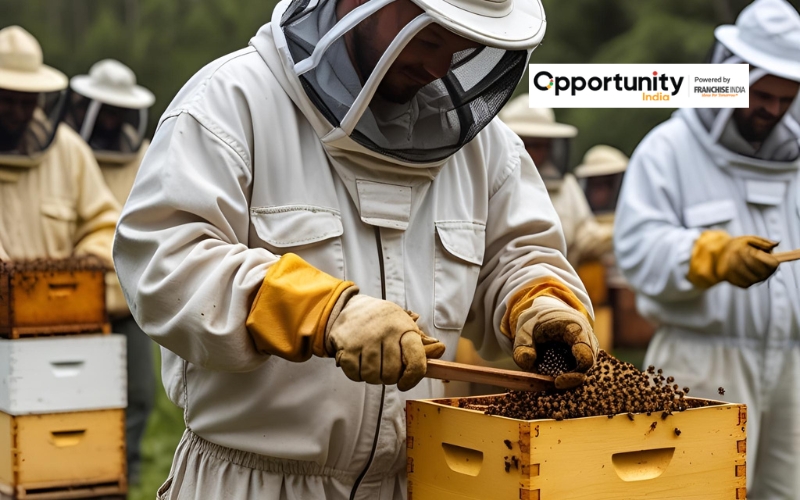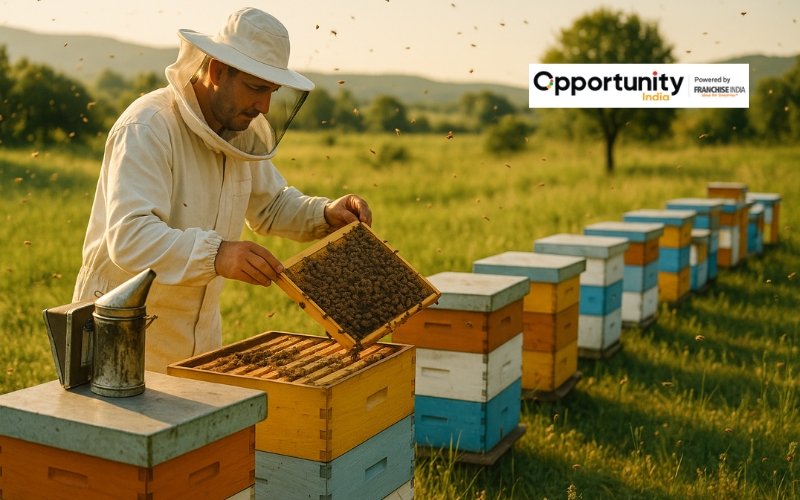
Have you ever considered how small bees could help you grow a large business? Sounds good, doesn't it? That's because it is! In India, apiculture—the production of honey bees—is quickly rising to the top of the list of lucrative and sustainable industries. Beekeeping might be the perfect chance for you if you're a farmer, a nature enthusiast, or someone wishing to launch a low-risk business. From the fundamentals to the remarkable returns, let's go over everything you need to know to launch your own honey bee farming business plan in India!
Why Start a Honey Bee Farming Business?
One of India's most lucrative and environmentally beneficial agribusinesses is honey bee farming. Beekeeping is becoming a financially feasible choice for small farmers, business owners, and young people living in rural areas due to the growing demand for natural honey, beeswax, royal jelly, and pollination services. India is a great place to keep bees because of its rich flora and varied agroclimatic conditions. Traditional beekeeping has a long history in the nation, and with the help of modern scientific methods, the sector is expected to grow significantly.
Also Read: Is Summer the Right Time to Invest in a Franchise?
According to IMARC Group, the Indian honey industry was valued at INR 27.0 billion in 2024 and is projected to grow at a compound annual growth rate (CAGR) of 7% from 2025 to 2033, reaching INR 50.0 billion. Several product innovations and versions, the implementation of government of India (GoI) initiatives and training programs, and the growing frequency of chronic medical conditions are some of the key drivers driving the market.

A low-risk, high-reward endeavor, beekeeping enhances other agricultural pursuits. It may be established in both rural and semi-urban locations and requires very little land. The following are strong arguments in favor of honey bee farming:
- Growing Demand: Due to its extensive use in food, medicine, and cosmetics, as well as growing health consciousness, honey is in greater demand than ever before.
- Low Investment, High Returns: Beekeeping can have a comparatively modest initial investment as compared to many other agricultural endeavors, particularly for businesses of all sizes. The returns can be significant if they are managed properly.
- Sustainable and Eco-Friendly: Beekeeping is a sustainable hobby that makes a substantial contribution to pollination, which is essential to agriculture and biodiversity. It encourages ecological balance and sustainable land use.
- Government Support: The Indian government actively promotes beekeeping as a way to diversify agriculture and generate rural livelihoods through a number of programs and initiatives.
- Export Potential: Indian honey is becoming more well-known abroad, which creates opportunities for export and raises pricing.
Types of Honey Bees Used in India
Selecting the appropriate honey bee species for your area and business objectives is crucial before you begin:
- Apis cerana indica – The Indian honey bee, Apis cerana indica, is a well-tamed species that thrives in rural regions.
- Apis mellifera – European bees are renowned for producing large amounts of honey. Ideal for commercial farming.
- Apis dorsata – The huge, honey-producing rock bee, Apis dorsata, is challenging to cultivate.
- Apis florea - The small bee is more suited for amateurs and makes less honey.
Apis mellifera is the most lucrative option for commercial farming because of its increased productivity and simplicity of operation.
Also Read: How to Start an Embroidery Business in India?
Step-by-Step Guide to Start Honey Bee Farming in India
Acquire Knowledge and Training
A fundamental understanding of apiculture is essential before making any financial investments. You can participate in government training programs or workshops by:
- KVK (Krishi Vigyan Kendra)
- National Bee Board (NBB)
- State Agriculture Departments
- ICAR Institutes
Bee biology, hive management, pest control, honey extraction, and seasonal care are among the subjects discussed.
Select an Appropriate Site
The location of your honey bee farm is crucial to its success:
- Stay away from places where there is a lot of wind, pesticides, or industrial pollution.
- Select an area with plenty of nectar and pollen sources, such as wildflowers, sunflowers, mustard, eucalyptus, or fruit orchards.
- Make sure there is enough sunlight and a nearby water source.
- Place the hives on elevated stands or platforms away from bad weather.
Decide How Big You Want to Start
Here’s a rough idea:
| Scale | Colonies | Investment | Ideal For |
|---|---|---|---|
| Small | 10–20 | ₹50K–₹1 lakh | Beginners |
| Medium | 50–100 | ₹2–₹4 lakhs | Growing farmers |
| Commercial | 200+ | ₹7–₹12 lakhs | Full-time business |
Starting small is smart. It lets you learn without risking too much.
Also Read: 3 Powerful Reasons to Own a Pet Franchise
Purchase Bee Colonies and Equipment
The following basic supplies are required to set up your apiary:
Essential Tools:
- Bee boxes (also known as Langstroth hives or wooden hives)
- Bees that produce honey (colonies with workers, drones, and a queen)
- Hive support or stand
- Smoker (to calm bees during inspection)
- Gloves, protective clothes, and a bee veil
- Electric or manual honey extractor
- Uncapping the knife and tray
- Queen excluder and feeder
Bee colonies and hives are available from authorized vendors or governmental organizations.

Seasonal Care and Hive Management
The secret to productivity in hives is effective management. Here are some things to remember:
- Regular inspection every 7–10 days
- Keep the area surrounding the hives clean.
- Avoid infestations of pests (such as mites or wax moths).
- During lean times, supply sugar syrup.
- Swarm management in the spring
- After frames are 80% capped, harvest honey.
- Change the queen every 1-2 years to increase output.
Under perfect circumstances, each bee colony can yield 20–25 kilograms of honey annually.
Harvesting and Processing Honey
Honey is often harvested two to three times a year, depending on the region and flowering cycles. To extract honey from combs, use a spinning honey extractor. The procedure consists of:
- Uncapping honeycomb frames
- Spinning them in the extractor
- Filtering and storing in food-grade containers
- Properly labeling for sale
Use stainless steel equipment and practice good hygiene to prevent contamination. Additionally, you can add value to your honey by branding it with flavored infusions, raw honey, or organic certification.
Also Read: 9 Profitable Recycling Business Ideas
Marketing and Sales Channels
There is increased demand for natural and chemical-free honey in urban and foreign markets. You can market your goods by:
- Local farmers’ markets and fairs
- Organic and Ayurvedic stores
- Grocery chains and supermarkets
- Direct-to-customer through websites or social media
- Online platforms like Amazon, Flipkart, or BigBasket
- B2B bulk sales to cosmetics and pharmaceutical companies
Honey marketing heavily relies on branding and eye-catching packaging. To stand out, think about incorporating traceability, QR codes, and distinctive flavors.
Investment Breakdown for Small-Scale Bee Farming (20 Colonies)
| Item | Estimated Cost (₹) |
|---|---|
| 20 Bee Boxes + Colonies | 80,000 |
| Hive Tools & Smoker | 5,000 |
| Protective Gear | 3,000 |
| Honey Extractor | 7,000 |
| Initial Training | 2,000 |
| Miscellaneous | 3,000 |
| Total Investment | ₹1,00,000 |
Beekeeping is a way of life, not just a business. You're supporting agriculture, interacting with nature, and creating a steady source of income. Honey bee farming can provide you with consistent profits without posing significant dangers, regardless of your level of experience. Therefore, if you're prepared to take a step toward a sweeter future, this is the ideal moment to begin your journey into honey bee farming in India!

